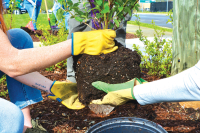A busy person’s guide to growing great salads
Tonight’s menu calls for salad from the garden, which reminded me to jot down a method for growing lettuce that, being very lazy busy lately, I’ve grown quite fond of doing.
Lettuce doesn’t need coddling, or careful spacing of the seed, or much of anything at all for that matter. Those expensive bags of mixed salad you buy at the farmers market or in produce sections of grocery stores? You can easily and inexpensively grow the stuff at home.
Here’s how you to grow your own Mesclun mix:
Broadcast lettuce seed thickly over a prepared garden bed. Broadcasting means strewing or scattering. A properly prepared bed is one free of rocks, amended with compost or, short of that, amended with organic fertilizer. The soil should have been limed to sweeten the soil, ideally some four months previously. The state extension service people will fuss at me about this — they do so like to recommend soil testing, probably in part because of the job insurance such testing entails — but don’t wait for results to come back from the laboratory if you haven’t tested and limed yet. I can pretty much guarantee that in Western North Carolina, home to acid soil, you need lime if you haven’t limed before. So get a bag of the stuff and, using a light hand, dust the top of the bed. It won’t hurt the seed, and this way rain will drive the lime down to where it can do the most good.
Your seed should be leaf lettuce such as Black-Seeded Simpson, not a heading lettuce. Though having said that I hasten to be contradictory by adding Buttercrunch lettuce — which is a Bibb type — works particularly well when broadcasted.
After you’ve gotten the seed down, stir it around a bit using the back of a rake. This presses the seeds into the soil and helps with germination. Don’t try to cover every seed, that’s unnecessary; in fact, some lettuces (the white-seeded types) need light for even germination. By stirring the seed you are simply trying to make some contact between said seed and the soil.
Related Items
Keep the bed moistened if the weather turns dry. This is very important because, using this method, the seed is more or less on the surface of the ground and subsequently will dry out very quickly. The lettuce generally germinates in about a week this time of year.
One wonderful side benefit to using my method if you, too, are really lazy very busy is that by broadcasting thickly, weeds are crowded out.
When the lettuce leaves have grown a few inches tall, take scissors and whack them off, a couple of inches from the ground: tah dah, you have salad. The lettuce will re-grow; you will take a pair of scissors and whack the leaves off again, fertilizing every couple of weeks (liquid fertilizer, such as compost tea or a fish emulsion). Over and over you cut, shearing the bed, at least you can do this until the weather turns really hot and the lettuce bolts or turns bitter.
You can help slow bolting by putting shade-cloth over top and watering frequently, but don’t bother until temperatures stay consistently in the 80s. Interestingly, once your lettuce starts tasting bitter, try rinsing it in warm water: for some reason, that helps more than cold water.
I’ve also found Slobolt, a leaf lettuce readily available through various seed companies, lives up to its name. I seed Slobolt in late spring to help tide me through the hot summer when Black-Seeded Simpson and Buttercrunch are a distant spring memory. I also have a hot-weather mix that I’ve grown for market I’ll write about another day. It has no actual lettuce (which is a cool-weather crop, and germination rates drop accordingly as temperatures rise), but instead relies on baby kales, collards and so on.
Other items that go into my salad mix this time of year: baby beet leaves, particularly the variety unappetizingly called bull’s blood beets. This type has lovely dark purple leaves and really dresses up a salad, but any young beet leaves will do. I also add claytonia, or Miner’s lettuce, a West Coast native that has a wonderful buttery taste; lamb’s quarters, a pernicious weed in our soil but a nice salad addition; sorrel; Asian greens such as tatsoi and mizuna; and Arugula.
Don’t forget to clip some dill or other herbs into the salad. I also enjoy adding edible flowers, such as violets or nasturtiums, for both beauty and gustatory pleasure.
(Quintin Ellison can be reached at This email address is being protected from spambots. You need JavaScript enabled to view it..)









